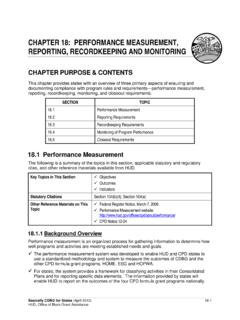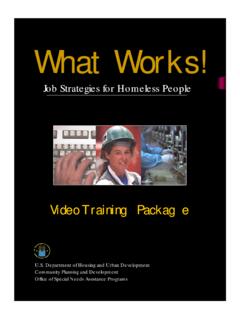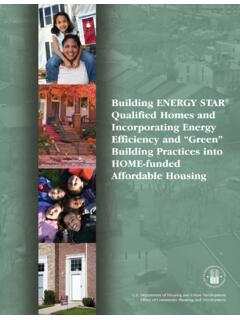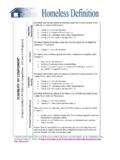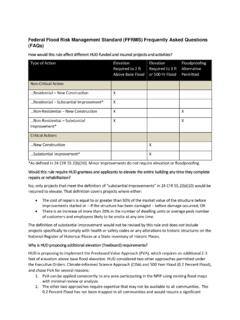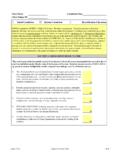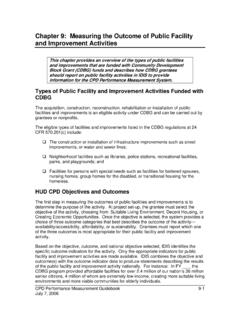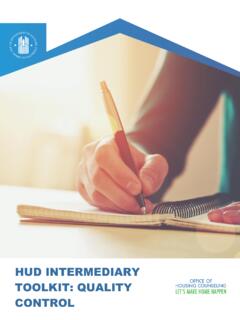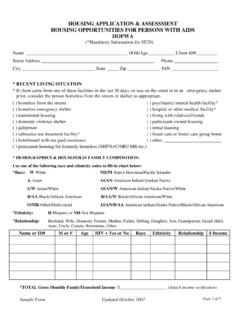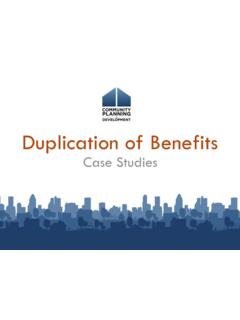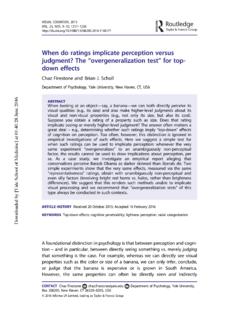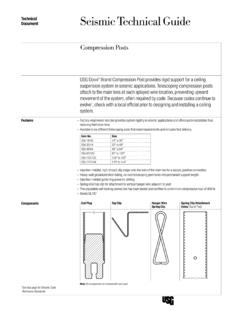Transcription of Noise Assessment Guidelines - HUD Exchange
1 ChapterS. Noise Assessment Guidelines Noise Assessment Guidelines 45. Noise Assessment Guidelines Foreword In choosing amongal1ernative sites for housing, potential Noise problems are prominent among the Issues that must be examined. These Noise Assessment Guidelines were developed to provide HUD field staff, Interested builders, devel opers. and loUt officials with an easy-to-use metllod ol evaluating Noise problems with a minimum ol time and effort We beloeve that this set of tools woll si mplify the process of belancing the goal of environmental protection with those of efficiency and reduced housing costs. We hope you wlllllnd them uselul, and invite your comments. Benjamin F. Bobo Acting Assistant Secretary lor Polley Developmenland Research ~~~\~. Assistant Secretary for Community Planning and Development Ill 47.
2 The Department of Houslng and Urban Oevolopment, in its eiiOitS to provide decent houSing and a suitable IMng env' Is c:oncemed wilh Noise as a majof aource ol 8I1 YWOill'll8nt polution and has issued part B 0t1 Noise Abatement and Control to Part S I ol rrtle 24 ol the Code ol Federal Regulations. The policy established by Subpart B em- bodies HUO objectives to mal<e the IISSOS$ . ment of the suitability ol the Noise etllliron . men1 at a site: (1) easy to par1otm:(2). unilonnly appi able to dille<enl Noise souroes; and (3) as c:onsis1ent as possiJie with the Assessment policies ol OCher Federal departments and agendo$. In furtherance of these objectives, the Office ol Polley Devei- Ojlment and Research has sponsored research to provide site analysis techniqoes. These Noise Asse$sment Guklelnes do no1.
3 ConstltUie established policy o1 the Oepan- ment but do provide a meh:>dology whose use IS eoc:ouraged by HU0 IS being con- sistent with Its Olljecti-;es. The Guk1ellnes provide a means for assessing separately the Noise produced by airport. highway. and railroad operations, as welt as the means for aggregating their CCliOOined ellect 0t1 the overall ncise environment at a sJte. This booklet has been prepared by Bolt Beranelt and Newman Inc:., under Coneract No. H 2243R for the Oepanment ol Housing and Urban Development. h IS a revision of an earlier edition published In August 1971 . With the exception ol changes made by the Department, the contractor Is solely responsible for the &CC~Kacy and completeMSS ol the data and lnformabon c:ontalned heren. IV. 48. Ill Foreword IV Poel- 2 Introduction 3 Combining Sound IAvelaln Declbela.
4 ARret! <4 Nee ! III'Y lnlom\llion <4 Eva1ua1ion oC SM Elcpoeure to Ama11 Noise 6 Roedwlya 6 Necessary lnlolmllion 6 Evaluation of She Expoeure to Roadway Noise 6 Automobile Tralllc: 7 Adjustmems tor Automobile Tralllc: 8 Truck Tratroc 8 Adjustments for Helvy Truc:ks 9 Attenuation oC Noise by Barriers 10 Steps to Evaluate~ 8lrrlet 14 Rlllwa,.. 1<4 Nee s5 5''Y lnlormiDon 1<4 Evaluation oC Site to Railway Noise 1<4 Oie$el Looomotlves 1<4 Adjustments for Oielel Locomotives 15 Railway Cars and Rapid TrllllSit Sys1ems 15 Adjustments lor Railway Cars and Rapid Transh Trains 17 Relei811C81. 18 SUmmary o1 Adfue1menl Faetora Introduction These Guidelines are j)feMnted as part ola should assess the coo oditioo, that w11 have the Noise enwonmenr acoeptable may be pro- CXlllbnUing effort by the Oepal1rnett ol Hous- most sevent ()(most lasting eflect on the use hOIJve and the outdoor enwonment would ing and Urban Development to provide olthesrta.
5 StiH be Unaoceptable. decent hooslng and a suitable living en- Wherever possible, you shoold try to WhenmeasuringthedistancetrOtntheslte vironment lor all Americans. assess Noise environments expected at least to any Noise source, measure from the The procedures described here have been ten years In the luture source to the nearest points on the site where de'leloped so that people Wllhout tec:hnicaJ The degree o1 80 Cllll)labilil o1 the noose buitdongs haVIOQ IIOISe-senslllve uses ara wll be able 10 assess the exposure o1 environment at a site is delem1ined by the located These points define the Noise a hoosing s~e to present and luture nolle outdoor day nlghl avarege sound level Assessment Locations lOt the site. The cond~ions. In this context, the she may hold (DNL) In decibels (d6). The Assessment of relevant measurement location lOt buildings only one small building, In which case the site acceptabilhy is presented forst as an is a point 2 meters ( feet) from the facade Noise Assessment is stralght!
6 Orward Larger evaluation ol the site's exposure to ltltee Hat any point during the HS ISS '"" Mthe sites may hold larger buildings, Ot many major aources ol noose - aJrcraft, roadways, site's exposure to !'lOlSe is lound 10 be buildongs, and the Noise level may be dd and reitways. These are then combined to Unacceptable Ot Normally Unacceptable, ferent at different parts ol the s~e (0< build- assess the total Noise at a she. Worl<&heels every effort should be made 10 Improve the Ing). Assessments ol the Noise exposure are provided at the back of these Guidelines cond~ion, .. the location of the proposed shoold be made at representative locations to use In 800'VIlalizing your evaluations. dwellings can be changed Ot 80<08 sNelding around the site where significant nolle is The Noise environment at a site w11 come can be pnovlded to bloclc the 1'10158 from !
7 Hat expected. These are deslgnaled as "Noose under one olltltee categories: source. Assessment Locations." abb<eviated Ac~ (DNL nolexoaeding 65 dec:l Where quiet outdoor space os desired at a the loftowing text. bels) The Noise exposure may be oi&Otne s~e. distances should be measured from the The only materials required are a map ot concem but common building construc:tions Important Noise sources to the outdoOt area the area. a ruler (straight edge), a proerector will make the Indoor environment accepUible in questiOn and the COiilbio Mid Noise expo- and a penc:l. WOtksheels and WOt1dng and the outdoor erwiroo oman1 wil be rea sure should be assessed figures are provided separately. sonably pleasant lor recreation and play. Frequently. the locatoons ol dwellings have All o1 the information you need can be Normelly Un8c cep Wb1t (DNL above 65 but not yet been 8jl8 Cified at the lime t!)
8 Le Noise easily obtained- usually by telephone. For not exceeding 75 decibels) The Noise expo- Assessment ol a sne Is made. In these convenience, this lnfoonation is listed at the sure is significantly IT'IOt8 severe; barriers instances, distances used In the Noise beginning ol each secdon under he <ings may be necessary be!""" the site and assessl1'l 1t should be measured as 2. that Indicate the most li<ely source. Whole prominent Noise SOUIQII 10 nWce the outdoor metets tess then the do$tanCe from the build- you are obtaining this lnformatloo. be sure to environment acceptable; special building ing setbacl< tine to the major soun:esol Noise . ask abou1 any approved plans for luture constructions may be necessary to ensure changes that may affect Noise levels at the that people Indoors are sufficlently protected site - for example: land-use cllanges.
9 From outdoor Noise . changes In airpofl runway lraffic. wldenong ol Un8c cep Wblt (ONL above 75 decibels) The roads, and so forth. In d evalualions. you Noise exposure at the she Is so severe IN! the oonstruc:tlon cost to make the Indoor 2. 50. Combining Sound ~Awls In Decibels The Noise environment at a arte Is dele< Use the table by first finding the mined by combining the c:onlrib<Aions of dif difference In IOUnd level betueen two lewle le<ent Noise sources. In lhe$e Guidelines . being combined. ~ the table with this WOftccharts are provided to estimate the oon- value, lind the value to be added to the larger tribution of aircraft, automobi~. trudc. and of the two levels, add this value to the larger train Noise to the total day nlght average level to determine the total. Where mo<e than eound level (DNL) at a Site The DNL conlrl- two,_.
10 Erelo be combined, use tne ume butions from each source ere ~ In procedure lo oombine any two leYels; .., decibels and entered on w~ A. The use this ~ and wet ibio oe wltl1 any c:omboled DNL from all the - I s the OCher level, and ao on. Ftadional runerical ONL fo< the Site and Is the value used to val\Ms may be Interpolated from !he table;. determine the acceptability 01 the Noise however, the ftnal result should be rounded environment. to the nearest whole number. Soond levels in decibels ere not combined by simple eddlticnt The following table shows how to combine soond le\lels: T- Doft ence ., AddiO. Sound~ latglr~A*. 0 30. 1 25. 2 21. 3 4 5 6 7 6 08. 9 10 12 14 02. 16 01. grutor lhan 16 0. Example 1 : In petfooning a s~e evaluation, the separate ONL values lor alrpons, road traffic, and railroads have been listed on WOibheet A as 56, 63, and 61 decibels.
